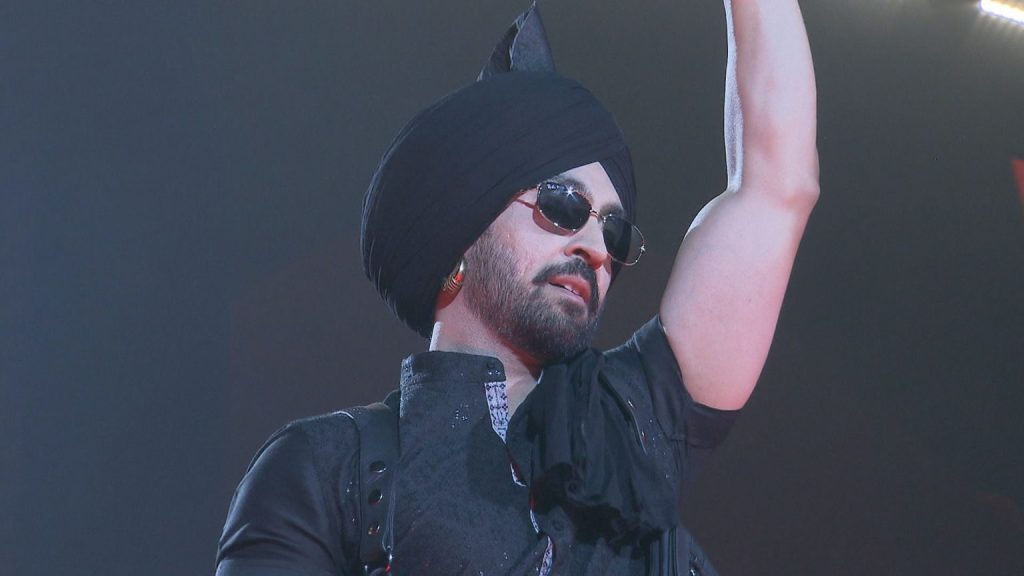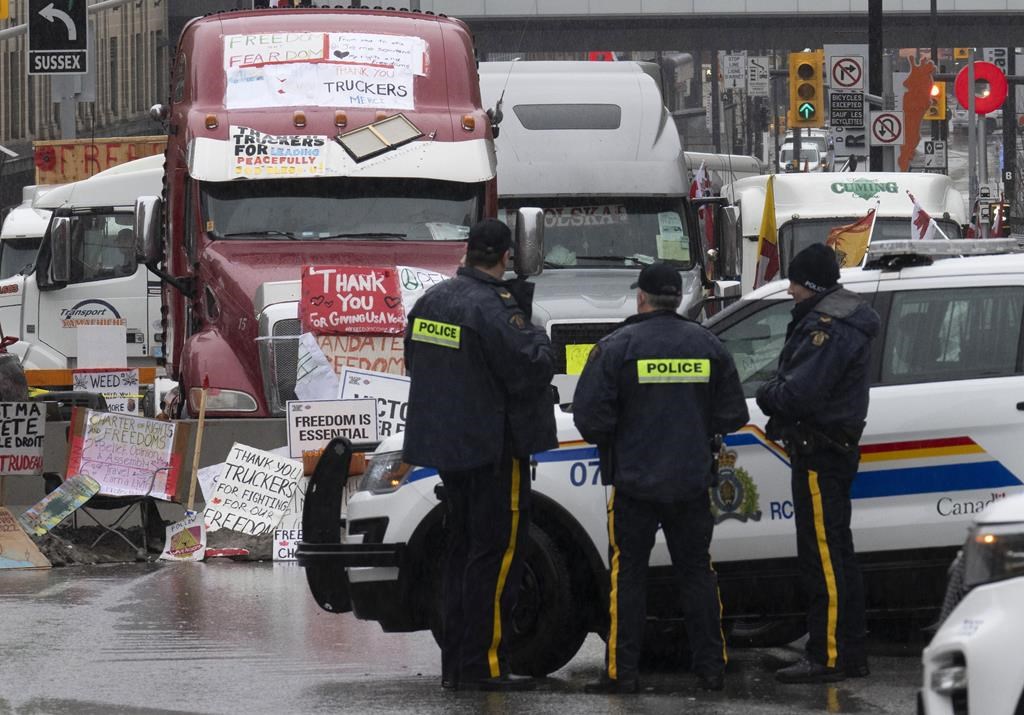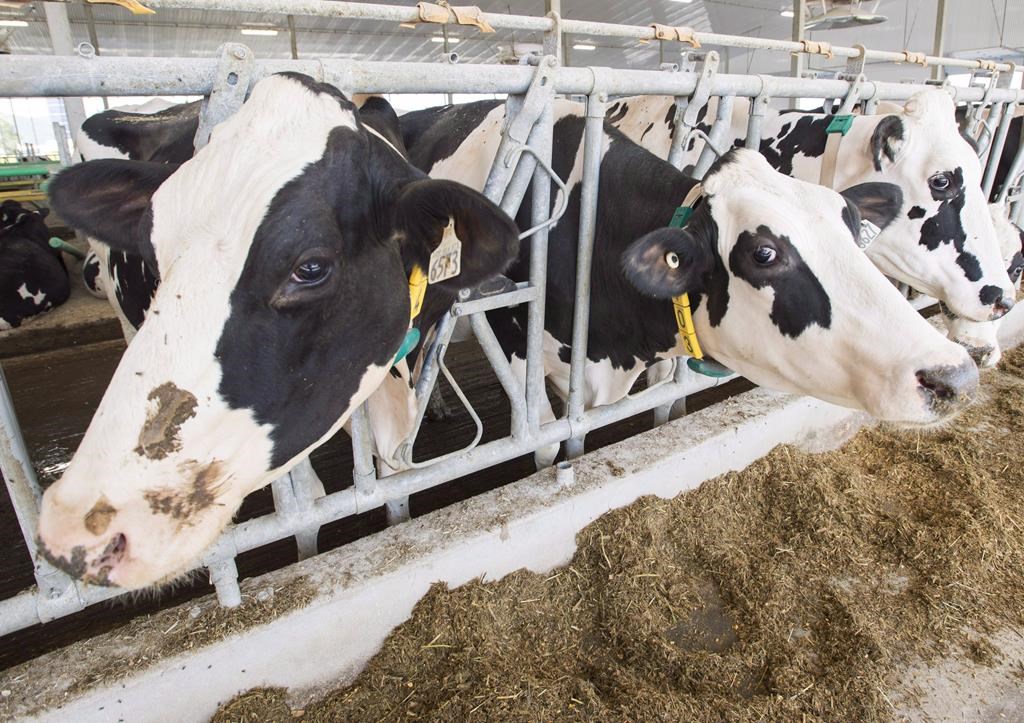‘Why play chess if a machine can beat a human?’ Calgary artist hopeful amid rise in AI art
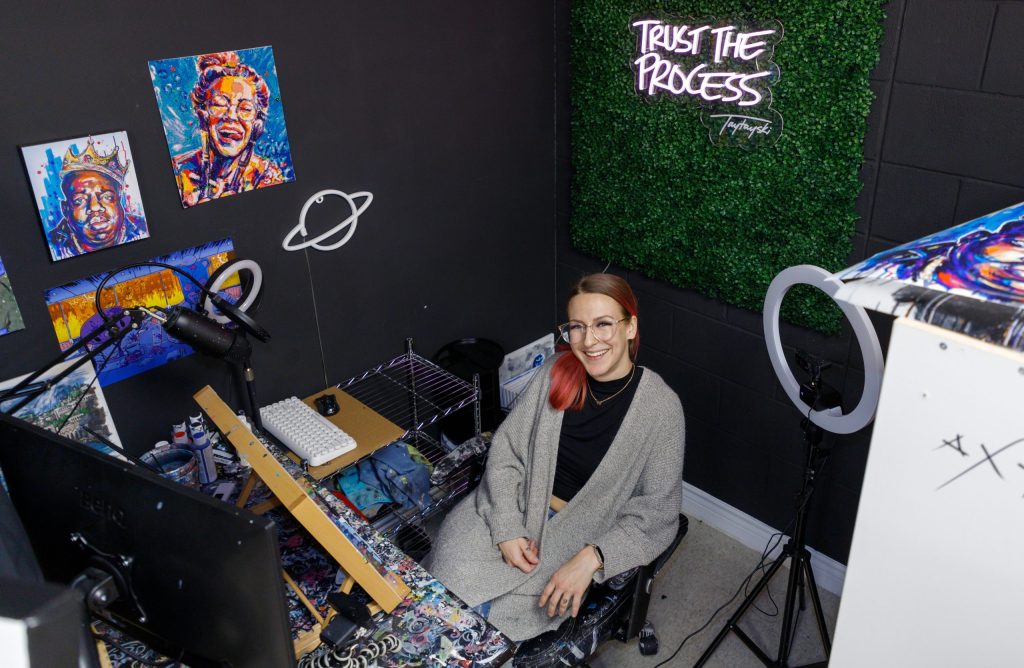
Posted April 25, 2023 7:06 pm.
Last Updated April 25, 2023 9:15 pm.
Taylor Odynski, a Calgary artist and “painter for the people,” made a career out of what she loves, but concerns swirl as artificial intelligence (AI) can do what she can for a fraction of the time and price.
AI art has hit the mainstream with programs from OpenAI, the company behind ChatGPT, being used to create images, videos, and music using prompts.
Videos like “Harry Potter by Balenciaga” or “Breaking Bad as an 80s Dark Fantasy film” have grown in popularity on YouTube and are created with programs like Midjourney, DALL E, and Elevenlabs.
In addition, an AI-generated song using the voices of Drake and The Weeknd went viral, despite them never collaborating.
Bans were placed on the song, with the record label Universal calling for the removal from online music stores.
Read More: Fake Drake: AI-generated track with Toronto rapper and the Weeknd pulled down
Odynski, who has been painting professionally for nearly 10 years as “Taytayski,” says she enjoys crafting work with other people’s ideas in mind, even saying what she does is like what people seek with AI art.
“Slaying paintings on the streets is what I always joked about doing,” she told CityNews in an interview. “Illustration is the job for me.”
“I’m just painting because I love painting. I don’t give a (sic) what it is, but it’s the joy that my client gets or that the other person gets out of it, that is my pusher.”
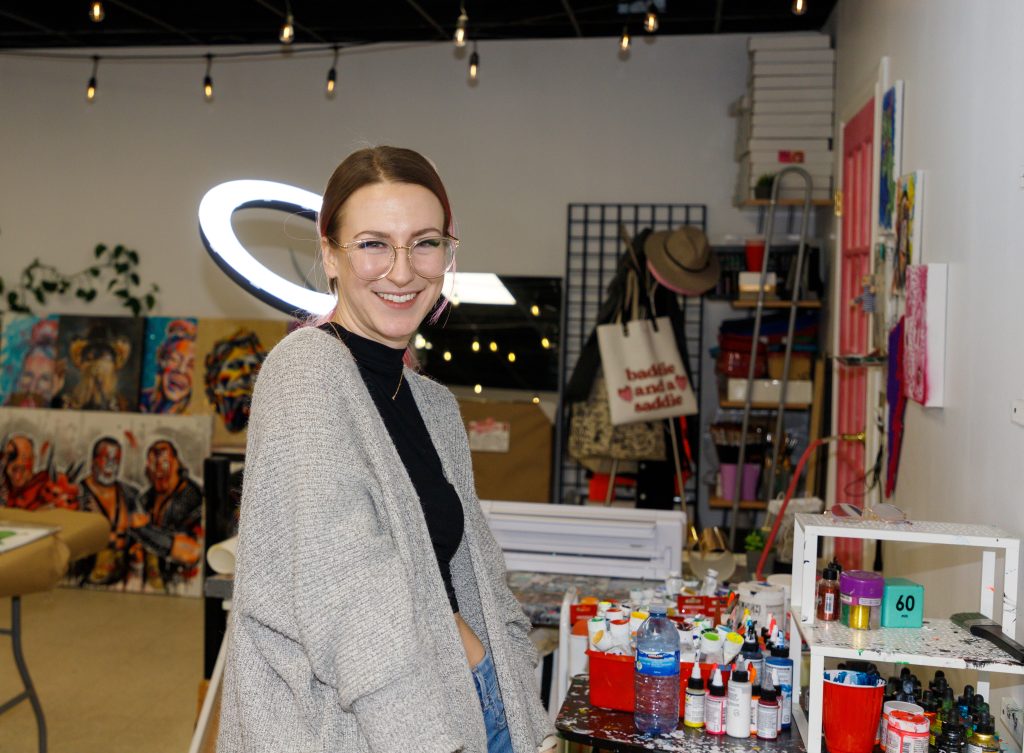
Tay Odynski poses for a photo in her studio in Calgary on Friday, April 14, 2023. She has been painting for a living since she graduated from AUArts in 2015, and calls herself a “painter for the people.” (Alejandro Melgar, CityNews image).
However, she says claims of artists using AI art as their own, other artists allegedly using their work without consent, and AI copycats undermining creatives, Odynski, while initially enamoured, simply says she “hates it.”
“It’s been a roller coaster of emotions when it comes to this whole AI introduction, and it’s getting (sic) crazier, which is just madness,” Odynski said.
“I feel like every day it’s a new crazy AI story that you’re like … where’s this going?”
Commission and AI
While paintings have been Odynski’s main career builder, she says getting them into print form has given her the opportunity to connect with people globally.
“People can have a piece of the art without the high price because not everybody is in that market,” she said.
“The price to time … is it is different for everybody. You have to find your market of people.”
Her paintings range from under $1,000 to $1,600. Odynski’s most expensive painting is of a group of horror movie villains in a depiction of The Last Supper, which sold for around $8,000.

Tay Odynski, right, poses with Kyle inside his home. He has regularly commissioned work from Odynski. (Courtesy Tay Odynski.)
She was also commissioned to add colour to the halls of an apartment building near the Alberta Children’s Hospital with 30 paintings.
In addition, Odynski says her paintings can take 10 hours at a time.
In comparison, an app that uses AI to produce animated selfies, is around US$5.
“Why wouldn’t you spend five bucks and get it fast,” Odynski said. “I would too.”
Lensa made headlines at the end of 2022 as controversy arose around artist usage, as it was reported that it “scraped” artwork online and “borrowed” styles from artists.
AI art generators, like DALL E, take less than a minute to produce a “painting” and is free for the first 50 images.
Odynski says 2022 was the first time she saw less money come in than the previous year. While she admits AI may not be the issue, the price tag, or lack thereof, of AI art and the scrapping of existing art is a cause for concern.
Related Stories:
-
Content creator shares warning of privacy concerns with social media trends
-
Ethics of AI: Video from the Alberta Party raises concerns
Dr. Jim Parker, a University of Calgary professor who was initially in the field of “informatics,” computer science, and now art, says it’s common for producers of the “next new thing” to hold a monopoly on a new medium, but ultimately, artists will hop in as it will call for their creativity.
“Digital art was the realm of programmers, and it was pretty banal until some of the artists came in and said, ‘Well, look, we know about color,'” he explained.
“People are going to use the AI aspects of art to help in their creation of things. And it’s only been a year since some of this stuff has become easily available, meaning that we just haven’t had a chance to accommodate it. But it’s something that is going to be incorporated into the standard tools of users.”
Artists rail against AI, creators share works with public
Getty Images filed a lawsuit against Stability AI, a company based in the United Kingdom, in January for “infringing intellectual property rights.”
In addition, a collection of artists filed a class-action lawsuit in San Francisco against AI image generators, including Stability AI.
Read More: AI tools can create new images, but who is the real artist?
However, some creators have been playing around with the likeness of U.S. presidents and Canadian politicians and placing them in different settings, like Alberta Premier Danielle Smith as an 80s rocker.
Craig Baird, the host of the Canadian History Ehx podcast, said the works he has created using Midjourney have been a new way to introduce people to the history of Canada.
Danielle Smith, Alberta pic.twitter.com/oYtZ4J7xQs
— Craig Baird – Canadian History Ehx (@CraigBaird) April 1, 2023
“With the prime ministers as hair metal musicians, and then prime ministers as hobbits, where people go, ‘Oh, I didn’t know who these prime ministers were,’ and they start to look into it, and teachers say, ‘Oh, this is a really interesting way to teach children about Canadian history, or about the prime ministers…’ or whatever I might be talking about,” he explained.
“So, for me, it was a really good way to get people interested in Canadian history, which is essentially, what I’m always trying to do.”
Canadian Prime Ministers as Hobbits.
Names generated at https://t.co/wvS7GpJbMA
23. Justin Trudeau (2015 – Present)
Hobbit Name: Fosco SandydownsAs PM: Legalized recreational cannabis, banned conversion therapy, took Liberals from 3rd place to majority in 2015. pic.twitter.com/JxQBZKsF3J
— Craig Baird – Canadian History Ehx (@CraigBaird) April 14, 2023
However, he acknowledges the concerns of artists like Odynski when he commissions MIdjourney to produce the work.
“I am very much not in favor of somebody paying somebody in exposure or something like that. You should be paid for what you do,” Baird said.
“But … I make my living podcasting. I don’t have a ton of money to pay somebody, so if I just want to generate something quickly to use as episode art, or just to get people interested in something, it’s a very good way for me to do it.”
He also says artists will continue to reign as the chosen form of expression for people.
“I know it’s not the same as a regular artist, and I really do understand where they’re coming from, but I don’t think we’re going to get to the point where AI artists is all we see because it lacks that human touch,” Baird said.
“AI art is not perfect. Many of my pictures have five fingers or look just kind of odd in a way. So, I don’t think it’ll ever replace human-made art. It’s just another form of a new branch, if you will.”
Leading up the Coronation, I'll share various created images of King Charles III.
He has made 17 Official Visits to Canada, five less than his mother.
His longest visit was 18 days in 1983. His shortest visit was 3 days in 2017 & in 2022.Here he is as an 18th century explorer pic.twitter.com/eWevFU47cB
— Craig Baird – Canadian History Ehx (@CraigBaird) April 25, 2023
Bans and regulations
The discussion around the use of AI has risen to a boiling point for some, as artists globally have been advocating for a ban. The hashtag “No to AI-generated images” has seen frequent use on social media.
Canadian artist named Sam Yang, with the YouTube channel Sam Does Arts, is a leading voice in the debate to ban the medium in the country.
While Odynski voiced her support for regulation and for the outright banning of AI art, she admits it may not be the right call.
“Someone can just punch in ‘cute bat in a fruit field,’ and you got this picture, and you’re selling it a bunch of times. It’s like, well, that would take me 10 hours to paint that,” she said.
“I know that art is art, and everybody expresses and does it differently, but a little part of you in there is like … come on.”

Dozens of brushes are holstered inside Tay Odynski’s studio in Calgary on Friday, April 14, 2023. (Alejandro Melgar, CityNews image).
She says one solution could be crediting artists who were “inspired” or borrowed from to create the AI piece.
“As much as artists are like, ‘Hey, don’t pay me in exposure,’ exposure is still huge. It’s still important,” she said.
“You still have to pay your bills, but … if your name was popping up every once in a while, it could be good for you if the right person could see it — but as long as you’re getting that recognition.”
However, Parker thinks there needs to be a reconciliation between engineers and artists before progress can be made.
He says there is a “vitriolic discussion” online, with artists expressing frustration at those in the tech industry while the artists are criticized for being “jealous.”
“The anger is misplaced,” he explained. “The AI is doing the work. It’s doing the rendering, and it’s doing the combining of the ideas expressed in a few simple words to create an image.”
“The people … typing in the prompts are not artists. It’s clear to everybody except for them that they’re not, they’re telling someone what they want drawn, and they’re not doing it.”
Read More: Learning to lie: AI tools adept at creating disinformation
Meanwhile, Parker says there are careers in illustration that may suffer due to AI. Books are one area, namely children’s books.
“When you have a publisher who doesn’t want to pay money for a book cover and don’t have a particular style they’re worried about, then they can just produce art for those kinds of books,” he said.
In addition, he says the rise in AI usage is an opportunity to adapt.
“We have to figure out a way to live with this, because it’s always happened before. And it’ll happen again, that technology will in some place, change the way people’s jobs are done,” Parker explained.
“I think this is going to happen more and more, and what happens when there are no more jobs for people? So, we have to think ahead about how to deal with this.”
One solution Parker proposed was taxing AI and providing income and financing for those impacted by the changes.
Is inspiration the same as stealing?
While AI art proves to be an issue for artists like Odynski, she admits there is a similarity in how artists are inspired.
“I think it is amazing that you could just write down some words and see what pops up and use that as inspiration moving forward, because it’s just what you do all the time,” she said.
But she says this poses a greater question: “Am I doing what an AI does?”
Parker says it is different because an artist has a vision while AI lacks one.
“AI is simply producing picture, after picture, after picture, of things that seem to match a phrase or something that you have given it,” he explained.
“The essential basis of art is in a form of communication between people.”
Read More: Toronto tech firm aims to reduce energy use in AI
He says an artist will convey emotions, feelings, or in Odynski’s case, the desires and vision of another person, while an AI only knows how to respond to prompts.
Parkers adds programs that people use to draw inspiration are a productive use of AI.
“She has an idea on what she wants to convey, whether it be an emotion or feelings, and the AI is giving her ideas in the same kind of way that some of these brainstorming programs online do when they generate random words for you,” he explained.
“In my mind, that’s actually a pretty reasonable way to use an AI program if you’re an artist.”

Tay Odynski poses for a photo in her studio in Calgary on Friday, April 14, 2023. She calls herself an illustrator who is commissioned to paint or illustrate for people. (Alejandro Melgar, CityNews image).
Odynski posed a challenge, an idea for an exhibit.
“An interesting project, which could also be another art show, would be me and an AI machine getting the same prompt and seeing what I come up with and seeing where [it] goes,” she said amid laughter.
In the meantime, she says the best way to keep herself on the map is to connect with people.
“We, as traditional artists, have to hold on to … that human connection, right? You don’t get to sit down with a robot and shoot the (sic) and talk and bounce off ideas and create something.”
She says that over time, other industries may adopt AI in their field in one way or another, but people will want to connect personally at some point.
After speaking with CityNews, Odynski showed off a painting she completed for the upcoming Calgary Comic Expo slated for April 28.
It consists of Pedro Pascal and Bella Ramsey as Joel and Elly, the main characters of the HBO series based on the Rockstar video game of the same name, “The Last of Us.”
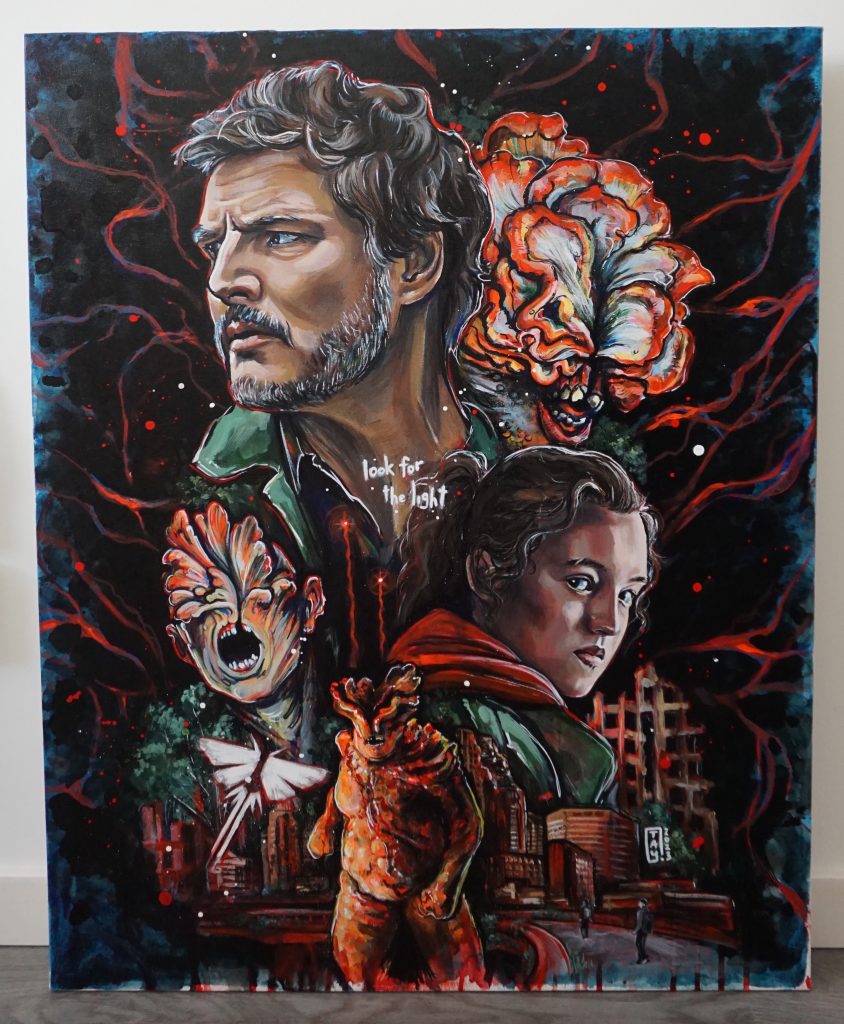
A painting consisting of characters from the HBO TV show “The Last of Us.” It will be on display at the 2023 Calgary Comic Expo. (Courtesy of Tay Odynski)
While her forte is characters, actors, and commissions from people, which AI prompts can do as well, she asks, “Why continue to play chess if a machine can beat a human?”
“I enjoy making art. So why would I let this machine stop me from doing that?” Odynski said.
“It’s a little piece of me that I couldn’t imagine not doing it my whole life. It’s just a natural thing that I like to do.”
AI art takes a matter of seconds to produce, and it’s only going to get better, but Odynski says it was hard work that got her to where she is, and she will keep on trucking and “slaying paintings” for those that appreciate “real hands.”

